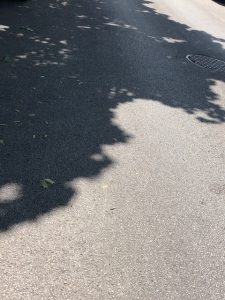 The other week, I met a couple friends at the Chicago Botanic Gardens, a large complex of beautiful flowers and fountains about twenty miles north of downtown Chicago.
The other week, I met a couple friends at the Chicago Botanic Gardens, a large complex of beautiful flowers and fountains about twenty miles north of downtown Chicago.
Being in the Age of COVID as we are, we observed extra restrictions. Reservations were required (to help plan for social distancing) as was wearing face masks. Directional signs were posted to keep the flow of walking traffic moving in a manageable way, and bathrooms, outside of the main ones in the visitor center, were closed.
The get together was a planned excursion in observance of one friend’s birthday. The visit was more complicated than it would normally be, and it was extremely hot, but we were happy we had some place where we could gather safely for honoring the day.
My friend Nina picked up the birthday girl and food from a favorite regional fast food chain on the way. It was my job to find a shady spot among the picnic tables along Parking Lot 2.
It seems weird that my sole mission was to find SHADE for enjoying our salads and Pellegrino but, as the temperature was in the mid-nineties, creating a state of comfort and ease before embarking on a masked promenade through the grounds was a difference-maker.
To claim the last picnic table under a tree and still close (and visible) to the pavement, I started spreading out a few possessions; my friend’s birthday gift, my water bottle. I basked in the noticeable drop in temperature between my parking spot and our luncheon oasis and started contemplating the term “shade.”
“Throwing shade” was the first thing that came to mind.
It felt off to me that currently popular usage featured judgement or disrespect when my first thought was along the lines of RELIEF. Shade whether enabled by a tree, a building or a hat, was naturally felt as relief from the sun.
But I felt compelled to look at shade more deeply, differently, now that we’re in the Age of COVID and social tumult.
Being awash in SHADE seems to be about things not appearing in CONTRAST. Most people want to see things in black and white. Yet, it seems like so much is gray right now.
I believe a person’s choices either takes her closer to who she wants to be or moves her away from this ideal. People’s decisions and actions either move their tribe towards a better communal life or away from one.
These days, it’s not clear that we are moving in any clear direction. Different parts of the world, of our country, seem to be clamoring for different things, moving in different directions. Some aspects of our civic machinery seem to be stuck completely. The senate is not moving at all.
This is often the way it is during a transition. Gray is the color of transition. It’s neither black nor white. We’re not in the past, nor in the future. Events might be dramatic, but a change in our identity (on an individual basis or as Americans) is not quite set yet.
What do we want our world to look like? What — who do we want to be?
I’m encouraged by the sustained efforts of young people to call attention to social justice issues, also that historically privileged cross-sections of the population are seriously contemplating the legacy of slavery and the importance of making voting rights laws more than symbolic.
But, as a country, we’re not ready to declare if we’re going to focus on competing self-interests or creating a more perfect union.
We’re in a gray zone. We’re living under a different kind of shade.
Unlike the shade a tree creates over a picnic table or a street during the middle of a summer day, where we can find comfort and relief from the direct heat, I think we have to learn how to live in the discomfort of not knowing who we are right now. We can’t declare or describe our identity…
Until we’re ready. Until we’re ready to back up our promises with actions.
Spending time in this kind of SHADE until we are clear what we want to look like, is no small thing.


Leave a comment